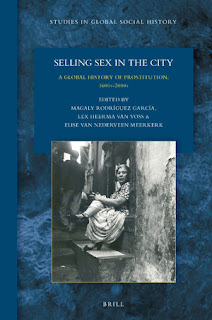Terminology: from whore to sex worker
Whores (hoer)
Receiving payment for sexual services in the early modern period,1500-1800, was illegal. Interesting sources to find women involved in these illicit activities would be confession books (confessieboeken) where interrogations of prisoners suspected of crimes were recorded. Another "meeting place" would be the old aldermen's court records (Schepenbank).(1) A woman who provided sexual services for payment is described in these records as a whore. But the meaning of this particular word in that era is broader than providing sexual services for money. Lotte van de Pol explains in her book that the term compiled all sexual acts and conduct outside of marriage. And even if sexual conduct within marital bliss would not lead to conception, this would be considered fornication.
Public woman and prostitute (publieke vrouw en prostituee)
With the arrival of Napoleon prostitution became legal in the Netherlands. After he left, the new Dutch king William I ordered in his first Royal Decree in 1818 that municipalities should install regulations with regard to: 'playhouses, so-called silent houses, and public women'.(3) De Vries refers in her book to the Dutch State Commission which defined that a 'public woman -whether or not living in a house of fornication- commits fornication in such a house with different persons'.(4) This broad and general definition could vary, however, within local regulations of municipalities.(5) Overall legalization meant registration of this group of women and the phrase is commonly applied in nineteenth-century Dutch resources. Prostitute is mentioned as well, although less frequently in official registers and documents during that time period. The new Dutch Winkler Prins Encyclopedia of 1870 included prostitution, describing it as the conduct of persons of the female sex, who give their bodies for money to commit fornication.
Sex worker (sekswerker)
The phrase sex worker first appeared around the 1980s and originated from women working in the sexual service business. The word prostitute had become synonymous with trafficking and exploitation and they protested that not every person working in the industry felt abused or a victim. With the new expression sex worker, the emphasis was instead put on economic activity. Prostitution was regarded as a profession to earn an income. The term also included a larger group of people working in the sex industry, for instance, strippers, porn actors, sellers of sexual services by phone and owners of erotic stores. Preventing abuse within this commercial industry was considered a task of the government.(6)
The Dutch government has currently adopted the terms, prostitute and sex worker, both with a similar definition: 'the person who makes him/herself available to perform sexual acts transactions with another for payment.'(7)
Definitions
Terminology changes over time. What is customary in one period can have a completely different meaning in the next. That makes archives even more intriguing. The language used in government records on prostitution provides additional information. To avoid misunderstandings it is therefore vital for historians, to explain the context of the terminology that is used in primary resources and also to define the expressions they use when writing on the topic.
I am inclined to use terminology from the time I am researching and find in the official government archives. In my case, I focus on the nineteenth century and so would use: public women or prostitutes. Giving a description is another way to mention them without constantly using official terminology. For instance: women working in the sex industry. It emphasises the work aspect since my PhD research focuses- on the perspective of labour.
Notes
(1) See my Dutch blog on the Schepenbank records in the Dutch city of 's-Hertogenbosch.
(2) Lotte van der Pol, De burger en de hoer. Prostitutie in Amsterdam (Amsterdam 2004) 14. The book is also translated into English: Lotte van de Pol, The burgher and the whore. Prostitution in early modern Amsterdam (Amsterdam 2011).
(3) Maritha Mathijsen, De gemaskerde eeuw (Amsterdam 2002) 66.
(4) (5) Petra de Vries, Kuisheid voor mannen, vrijheid voor vrouwen: de reglementering en bestrijding van prostitutie in Nederland, 1850-1911 (Hilversum 1997) 28-29.
(6) Rodriguez Garcia, M., L. Heerma van Voss, and E. van Nederveen Meerkerk (eds), Selling Sex in the City: a Global History of Prostitution, 1600s-2000s (Leiden 2017).4-6; J. Bindman, 'Redefining prostitution as sex work on the international agenda'. Report Slavery International (Vancouver 1997).
7. Definition translated from the Dutch law on regulating prostitution of 2020, Kamerstukken II 2020/21, 35715, nr. 4.
Another government resource that uses both terminologies is: Rijksoverheid.nl
*image S. de Vries, 't Amsterdamsch hoerdom: behelzende de listen en streeken, daar zich de hoeren en hoere-waardinnen van dienen; benevens der zelver maniere van leeven, dwaaze bygelovigheden, en in 't algemeen alles 't geen by dese juffers in gebruik is (Amsterdam 1710) Book is online available via Google Books
[updated: 06-06-2024]



Comments
Post a Comment